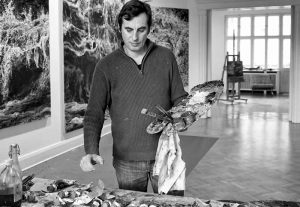WORDS/FAKE WORDS: Part VI
Our magazine in close collaboration with LISTE Art Fair, as part of our media partnership on a regular basis, begins a new column in response to the social, political and economic situations, occurring globally, the dimensions that begin to take and the way that all these affect contemporary art and art world. For 3-4 times every month, we are putting questions and concerns to influential people in the art world, setting a discussion, bridging the thoughts, worries, concerns and searches of all of us for the present and the future.
 As a reference point the rise of neo-conservatism and the sneaky way that are violated and restricted individual and social freedoms globally, which are the result of hard struggles of the past, we put our relevant question. In the Part V, we have Answers from: Isabella Ritter & Katharina Schendl (Founders of LambdaLambdaLambda, Prishtina) and Dimitris Tzamouranis (Greek Artist, lives and works in Berlin for 25 years).
As a reference point the rise of neo-conservatism and the sneaky way that are violated and restricted individual and social freedoms globally, which are the result of hard struggles of the past, we put our relevant question. In the Part V, we have Answers from: Isabella Ritter & Katharina Schendl (Founders of LambdaLambdaLambda, Prishtina) and Dimitris Tzamouranis (Greek Artist, lives and works in Berlin for 25 years).
By Efi Michalarou & Dimitris Lempesis
One of the biggest problems of our time is Migration. In the late ‘90s Globalization, Cultural Diversity and the Intersection of Ideas, have been issues discussed with great enthusiasm in the art world, supporting and highlighting artists from the so-called periphery of the globe. Today, if we redefine and bring back up the same issues, what means Globalization, Cultural Diversity and Intersection of Ideas nowadays? How are projects conceived and determined by the artists and the art world compared to the past?
 Isabella Ritter & Katharina Schendl (Founders of LambdaLambdaLambda, Prishtina): If we speak about artists from the so-called periphery of the globe we won’t be able to ignore a colonial perspective on these places, a gaze on them in terms of „otherness“. When we think about Eastern Europe with all its sub-categories as for instance the „Balkans“ then the art-production in the ’90s was evolving around questions of identity, either in terms of nation, gender, ethnicity and their respective construction. Today artists seem to refuse to produce these kind of homogeneous narratives due to an understanding that the situation is more complex and multi-layered than from the ’90s point of view, it this is due to a more advanced stage of globalisation is difficult to say. The „promise“ of globalisation has not fulfilled itself equally in all parts of the „periphery“. While the internet and other accelerated means of communication that count as vehicles for globalisation have done their respective part in creating a seemingly cultural interconnectedness around the globe, the absence of free movement is still a factor that hinders the full scope of globalisation to unfold itself in certain places, as it is the case in Kosovo. Hence there exists a gap between this projected idea of a cultural globalisation and the factual reality. It seems to be this very gap that is explored by artists and taken up for discussion in this part of the so-called periphery of the globe.
Isabella Ritter & Katharina Schendl (Founders of LambdaLambdaLambda, Prishtina): If we speak about artists from the so-called periphery of the globe we won’t be able to ignore a colonial perspective on these places, a gaze on them in terms of „otherness“. When we think about Eastern Europe with all its sub-categories as for instance the „Balkans“ then the art-production in the ’90s was evolving around questions of identity, either in terms of nation, gender, ethnicity and their respective construction. Today artists seem to refuse to produce these kind of homogeneous narratives due to an understanding that the situation is more complex and multi-layered than from the ’90s point of view, it this is due to a more advanced stage of globalisation is difficult to say. The „promise“ of globalisation has not fulfilled itself equally in all parts of the „periphery“. While the internet and other accelerated means of communication that count as vehicles for globalisation have done their respective part in creating a seemingly cultural interconnectedness around the globe, the absence of free movement is still a factor that hinders the full scope of globalisation to unfold itself in certain places, as it is the case in Kosovo. Hence there exists a gap between this projected idea of a cultural globalisation and the factual reality. It seems to be this very gap that is explored by artists and taken up for discussion in this part of the so-called periphery of the globe.
 Dimitris Tzamouranis* (Greek Artist, lives and works in Berlin for 25 years): The development in the field of visual art, in the ‘90s, had to do with a very important historical fact, the fall of the Berlin Wall, suddenly the Soviet Union stopped to exist, the borders were open and an one-sided euphoria was created in the West, because it seemed that artists from the Periphery of the globe were emerging, but the main goal was to open new Art Markets. That’s why we saw are all these artists participating in major international exhibitions such as: Documenta, Biennale, Manifesta, Art Fairs etc., but many of them never entered the Art Market. At first this is a Political Game, don’t forget that great artists such as: Mona Hatum, Anish Kapoor or Shirin Neshat, emerged through a structured system as they lived in the West and their artworks functioned as a propaganda to their compatriots. The artists are innocent, at least the major proportion. I know many artists, who have a very special and serious body of work, but none of them is invited to participate in major art exhibitions, their artworks belong in some Private Collections but they don’t have the opportunity to exhibit and be recognized by a wider international audience. For me the problem has to do with the art system, where there is a question in relation with its past, but also the impeachment of the role and the identity of the artist. Suddenly we see in great art exhibitions, very remarkable people with an important background like: cinematographers, philosophers or musicians, to assume the role of the visual artists. So there comes the big impeachment about what is visual art and also a very principal question. Why major and main art platforms such as: Biennale, Documenta and the Great Museums are questioning the role and identity of the artist and replace him with very important people but unrelated to the visuals arts? Why all these visual platforms are mutating to party platforms? Because that policy represents the general international politics. This fact has to do with globalization? Yes, because this is the easier and politically painless method to spread a dominant ideology, for them Globalization and Cultural Diversity is a guise. In the early ‘90s Berlin, where I live and work for 25 years, became the New Center of Contemporary Art but now faces a huge problem. At first there was no Art Market for Contemporary Art and that gave to artists and the art people freedom, rentals for studios and galleries were cheap, and many experimental projects could be done. In this framework, there has been an explosion in Multiculturalism. The Art Market created in 2000, a year that many International Galleries opened in Berlin and there was tremendous euphoria and tension. It started to totter in 2007-8 with the bankruptcy of Lehman Brothers and in today’s crisis, areas like Mitte and Kreuzberg that were developed thanks to art and artists, are no longer artistic centers, because they are too expensive and they are full of boutiques for tourists and banks. From all these reasons have been made great changes in Berlin’s Contemporary Art Scene and now is very hard to live and work here, especially for young and foreigner artists.
Dimitris Tzamouranis* (Greek Artist, lives and works in Berlin for 25 years): The development in the field of visual art, in the ‘90s, had to do with a very important historical fact, the fall of the Berlin Wall, suddenly the Soviet Union stopped to exist, the borders were open and an one-sided euphoria was created in the West, because it seemed that artists from the Periphery of the globe were emerging, but the main goal was to open new Art Markets. That’s why we saw are all these artists participating in major international exhibitions such as: Documenta, Biennale, Manifesta, Art Fairs etc., but many of them never entered the Art Market. At first this is a Political Game, don’t forget that great artists such as: Mona Hatum, Anish Kapoor or Shirin Neshat, emerged through a structured system as they lived in the West and their artworks functioned as a propaganda to their compatriots. The artists are innocent, at least the major proportion. I know many artists, who have a very special and serious body of work, but none of them is invited to participate in major art exhibitions, their artworks belong in some Private Collections but they don’t have the opportunity to exhibit and be recognized by a wider international audience. For me the problem has to do with the art system, where there is a question in relation with its past, but also the impeachment of the role and the identity of the artist. Suddenly we see in great art exhibitions, very remarkable people with an important background like: cinematographers, philosophers or musicians, to assume the role of the visual artists. So there comes the big impeachment about what is visual art and also a very principal question. Why major and main art platforms such as: Biennale, Documenta and the Great Museums are questioning the role and identity of the artist and replace him with very important people but unrelated to the visuals arts? Why all these visual platforms are mutating to party platforms? Because that policy represents the general international politics. This fact has to do with globalization? Yes, because this is the easier and politically painless method to spread a dominant ideology, for them Globalization and Cultural Diversity is a guise. In the early ‘90s Berlin, where I live and work for 25 years, became the New Center of Contemporary Art but now faces a huge problem. At first there was no Art Market for Contemporary Art and that gave to artists and the art people freedom, rentals for studios and galleries were cheap, and many experimental projects could be done. In this framework, there has been an explosion in Multiculturalism. The Art Market created in 2000, a year that many International Galleries opened in Berlin and there was tremendous euphoria and tension. It started to totter in 2007-8 with the bankruptcy of Lehman Brothers and in today’s crisis, areas like Mitte and Kreuzberg that were developed thanks to art and artists, are no longer artistic centers, because they are too expensive and they are full of boutiques for tourists and banks. From all these reasons have been made great changes in Berlin’s Contemporary Art Scene and now is very hard to live and work here, especially for young and foreigner artists.
*Dimitris Tzamouranis participates at documenta 14 in Kassel in the main exhibition with artworks from EMST (National Museum of Contemporary Art, Athens) Collection, also on 23/6/17 his solo exhibition “Mare Nostrum” opens at Galerie Michael Haas in Berlin.
First Publication: www.dreamideamachine.com
© dreamideamachine
Media Partner on a regular basis of LISTE Art Fair

